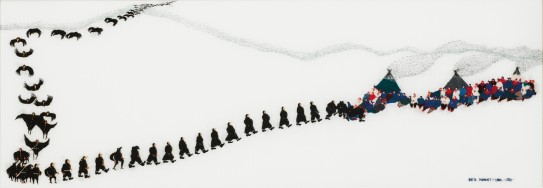Gina Gylver talks about «Garjját / Kråkene»

Transcription
|
Narrator At the end of the 70s, a fight to preserve the Alta-Kautokeino waterway in northern Norway began because the government wanted to construct a hydroelectric powerplant in the river. One of the longest and most famous demonstrations in Norwegian history takes place and the young Sami artist Britta Marakatt-Labba gets involved.
NRK The river will live! the river will live!
Narrator In 1981 they lose the fight.
NRK This morning, 14 demonstrators were removed by the police
Narrator In Britta's work Garjjat, The Crows, which hangs here, you can see how the policemen fly in like hungry crows and remove all opponents - taking everything they come across.
Now, the Sami are fighting a new battle against the Fosen development where wind turbines are placed on the land that the Sami are herding reindeers. Gina Gylver, head of Nature and Youth, tells us about her visit to Fosen in 2022.
Gina Gylver And, it is absolutely heartbreaking to be there and see the interventions, how enormous it is, how many turbines there are, but also construction roads and blasting stones, and all sorts of things. And to then hear the stories directly from the reindeer herders, and see it in their faces, how much it had destroyed. It made a really strong impression. And I think that's often the way it is, that as soon as you are personally touched, meet the people, it also obliges you in a way. It is not so easy to leave there and put it aside.
40 years after Alta, there are still human rights violations and violations of indigenous rights. There are still huge natural encroachments where people have not learned from history, do not understand that they are on the wrong side of history, that someone will have to pay, and are already paying drastically for what is happening.
Narrator The Sami reindeer herders at Fosen sued the Norwegian state and won. The turbines were to be demolished. But nothing happened.
Gina Gylver So, when it approached 500 days of human rights violations, we and several Sami activists decided that something had to be done now. We had to bring the matter to light and decided to go to the OED (the Ministry of Oil and Energy).
Narrator They stayed for 4 days, the last 24 hours without food or drink. Then surprisingly, the police came to pick them up in the middle of the night. And just then it was as if Britta Marakatt-Labba's artwork Garjjat/The Crows came to life
Gina Gylver It was a very strong memory that will stay with me for the rest of my life, I think. We woke up suddenly at the OED and 20 armed police officers stormed in and said you have 15 minutes to get out. We hadn't really slept, hardly in four days, because we were lying on the floor and in chairs in the OED lobby. Then we gathered and sat in a circle and waited for the police to remove us.
Then the Sami activists started to joike in Sami song tradition “Garjjat, garjjat, kra, kra, kra” because when the police came in, it was their immediate reaction. It was precisely that image of the police pouring in and carrying people away. So, I think that picture has become very special for everyone who was there, but also for the Fosen action in general.
|